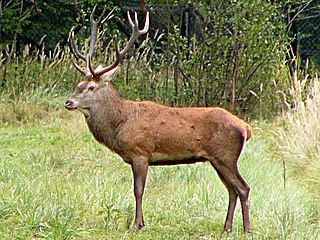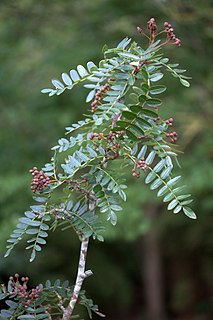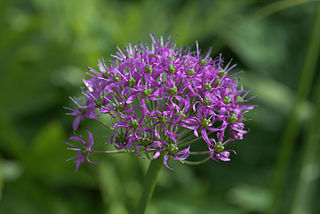
Arabidopsis (rockcress) is a genus in the family Brassicaceae. They are small flowering plants related to cabbage and mustard. This genus is of great interest since it contains thale cress, one of the model organisms used for studying plant biology and the first plant to have its entire genome sequenced. Changes in thale cress are easily observed, making it a very useful model.

The cheer pheasant, also known as Wallich's pheasant, is a vulnerable species of the pheasant family, Phasianidae. It is the only member in monotypic genus Catreus. The scientific name commemorates the Danish botanist Nathaniel Wallich.

Meconopsis napaulensis, the Nepal poppy or satin poppy, is a plant of the family Papaveraceae. The plant contains beta-carbolines, which act as a psychedelic drug. However, its phytochemistry remains predominantly unstudied.

Cervus is a genus of deer that primarily are native to Eurasia, although one species occurs in northern Africa and another in North America. In addition to the species presently placed in this genus, it has included a whole range of other species now commonly placed in other genera, but some of these should perhaps be returned to Cervus. Additionally, the species-level taxonomy is in a state of flux.
The Central Asian red deer is a primordial group of Elk subspecies, which is found at the southern and eastern rim of the Tibetan plateau. Sometimes it is treated as a distinct species.
Ligusticum striatum is a flowering plant in the carrot family best known for its use in traditional Chinese medicine where it is considered one of the 50 fundamental herbs. It is known by the common name Szechuan lovage, and chuānxiōng in Chinese: 川芎. It is native to India, Kashmir, and Nepal. It contains the phytoprogestogens 3,8-dihydrodiligustilide and riligustilide.
Castanopsis wallichii is a species of plant in the Fagaceae family. It is a tree found in Peninsular Malaysia and Singapore. It is threatened by habitat loss.
Horsfieldia wallichii is a species of plant in the Myristicaceae family. It is found in Indonesia, Malaysia, and Singapore.
Memecylon wallichii is a species of plant in the family Melastomataceae. It is a tree endemic to Peninsular Malaysia. It is threatened by habitat loss.

Sorbus wallichii is a species of plant in the family Rosaceae. It is found in China, India, and Nepal.

Brahmaea wallichii, also known as the owl moth, is a moth from the family Brahmaeidae, the Brahmin moths, and one of its largest species. It is found in the north of India, Bhutan, Myanmar, China, Taiwan, and Japan. The owl moth is nocturnal. The wingspan is about 90–160 millimetres.

Apostasia wallichii, commonly known as the yellow grass orchid, is a species of orchid that is native to India, Japan, China, Southeast Asia, New Guinea and northern Australia. It has many arching, dark green, grass-like leaves and up to forty small, star-like yellow flowers arranged on a branched flowering stem. It mainly grows in wet forest and rainforest.
Bulbophyllum wallichii is a species of orchid in the genus Bulbophyllum.

Dombeya wallichii is a flowering shrub of the family Malvaceae known by the common names pinkball, pink ball tree, and tropical hydrangea. Its native range includes India, East Africa, and Madagascar.
Valeriana wallichii is a rhizome herb of the genus Valeriana and the family Valerianaceae also called Indian Valerian or Tagar-Ganthoda, not to be confused with ganthoda, the root of Indian long pepper. It is an herb useful in Ayurvedic medicine used as an analeptic, antispasmodic, carminative, sedative, stimulant, stomachic, and nervine.

Rhododendron wallichii (簇毛杜鹃) is a rhododendron species native to northeastern India, eastern Nepal, Bhutan, Sikkim, and southern Xizang in China, where it grows at altitudes of 3000–4300 meters. It is a shrub that grows to 2–4 m in height, with leathery leaves that are elliptic to oblong-obovate, 7–12 by 2.5–5 cm in size. Flowers are purple-red to white, with red spots.
Wallichii, a specific epithet honouring Danish botanist Nathaniel Wallich, may refer to:

Allium wallichii is a plant species native to India, Nepal, Sikkim, Bhutan, Myanmar (Burma), Tibet and parts of China. It grows at elevations of 2300–4800 m.

Hemidesmus is a genus of plants in the Apocynaceae, first described in 1810. It is native to the Indian Subcontinent.
- Hemidesmus cordatus(Poir.) Schult. - India
- Hemidesmus indicus(L.) R. Br. ex Schult. - Pakistan, India, Bangladesh
- Hemidesmus indicus var. pubescensHook.f., syn of Finlaysonia wallichii(Wight) Venter
- Hemidesmus pubescensWight & Arn., syn of Finlaysonia wallichii(Wight) Venter
- Hemidesmus wallichiiWight, syn of Finlaysonia wallichii(Wight) Venter
Ceroplesini is a tribe of longhorn beetles of the Lamiinae subfamily. It was described by Thomson in 1860.












